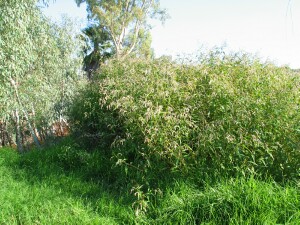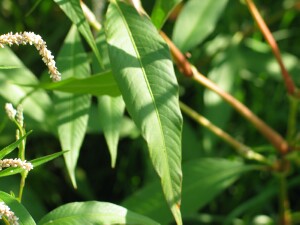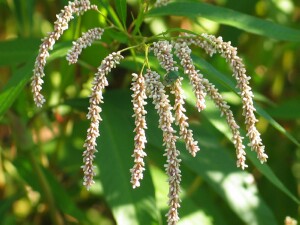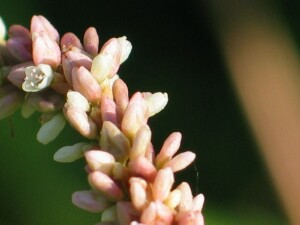Pale Knotweed
Back | Salinity Indicator Plants Home | Common name home | Scientific name home | Photo Gallery | Glossary
| Pale Knotweed photos | Family Name: Dock (Polygonaceae) |
| Scientific Name: | Persicaria lapathifolium (syn. Polygonum lapathifolium, Polygonum lanigerum) |  Pale Knotweed plant Photo: A J Brown | |||||
Other Common Names: | Pink Knotweed, Pale Smartweed | ||||||
Status: | Cosmopolitan plant which may or may not be native to Australia. | ||||||
Plant Description: | Erect to ascending, hairless, annual herb 50-180 cm high with ovate to narrow-elliptic, glandular, leaves, 6-21 cm long and 10-45 mm wide. Flowers in dense, elongate-cylindrical, drooping, spikes, 2.5-6 cm long and 4-7 mm diameter; the flowers crowding and overlapping and perianth (flower) segments, pink, 1.5-2.7 mm long. Fruit is a lens-shaped, brown to dark brown, nut, 1.5-2 mm long. | ||||||
Habitat: | Semi-aquatic plant of freshwater environments. Grows in water and on wet flats at the edges of rivers, lagoons and lakes and in marshes, swamps and drainage lines. High waterlogging tolerance.
| ||||||
Comments: | Pale Knotweed belongs to a group of about 10 species which were once treated as part of the genus Polygonum. The four species left in Polygonum are mainly introduced plants which frequent waste ground or weeds of cropping ground and are not associated with waterlogged situations. Other Knotweeds of wide distribution, include the Australian native Spotted Knotweed (Persicaria praetermissa), Creeping Knotweed (Persicaria prostrata), Slender Knotweed (Persicaria decipiens) and Water-pepper (Persicaria hydropiper). The introduced Persicaria or Redshank (P. maculosa) is a common weed of waterbodies in Gippsland. Its flower-spikes and shorter and broader than in Slender Knotweed | ||||||
 Pale Knotweed leaf Photo: A J Brown |  Flower-heads of Pale Knotweed Photo: A J Brown |
|



